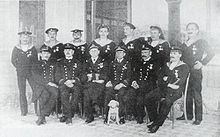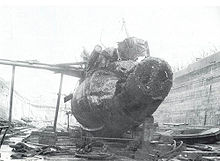SM U-12 (kuk Marine)
 U-12 entering the port of Pola in 1914 |
|
| Overview | |
|---|---|
| Shipyard |
Whitehead & Co., Fiume |
| Keel laying | March 14, 1911 |
| 1. Period of service |
|
| Commissioning | August 21, 1914 |
| Whereabouts | Sunk by a mine in August 1915 |
| Technical specifications | |
| displacement |
240 t above water |
| length |
32.11 m |
| width |
4.19 m |
| Draft |
3.91 m |
| drive |
2 shafts |
| speed |
over water: 10.75 kn (19.9 km / h) |
| Armament |
2 × 45 cm torpedo tubes, 4 torpedoes |
SM U 12 (His Majesty Submarine 12 - also U-XII) was a submarine of the Austro-Hungarian Navy during the First World War .
Development history
The submarine was built as the SS-3 in Robert Whitehead's shipyard in Fiume. Whitehead had the boat developed without having a specific assignment. The construction followed the designs of John Philip Holland , according to which the sister boats SM U-5 and U-6 were built. After the keel was laid in March 1911, Whitehead tried to sell the boat to the Austro-Hungarian Navy . In the Ministry of War in Vienna, however, the purchase was rejected because the U-5 and U-6 had already been put into service and were still pending operational readiness. Whitehead spent three years trying to find a buyer for the submersible. The high command of the navies of Peru , Portugal , Brazil , Bulgaria and the Netherlands showed no interest, so that Whitehead was finally able to convince the Austro-Hungarian Navy to buy it in a second attempt. When the First World War broke out , the boat was still unpaid and entered service as the U-12 in August 1914 .
The 28-year-old lieutenant of the line, Egon Lerch , was assigned as the commander, who led U-12 to its sinking.
First World War
One of the first combat operations in which the U-12 was involved resulted in a torpedo hit on an enemy battleship . U-12 torpedoed the French battleship Jean Bart in the Strait of Otranto , but was unable to sink the ship. The Jean Bart was escorting a convoy and was traveling slowly. The large-line ship received the hit just before the ammunition chamber, but was able to reach a port in Malta despite severe damage . A few weeks later the submarine sank a Greek cargo ship; it is the only officially known ship that was sunk by U-12 .
Downfall
In August 1915, the boat was assigned to search for mines in the Gulf of Venice . There U-12 was rammed and badly damaged by the Italian destroyer Rosolino Pilo on August 6, 1915 . Two days later, Italian seafarers heard a violent underwater explosion on a dredger at the point of the collision. Divers soon found the wreck of U-12 on the ocean floor. A sea mine had torn open the bow and tore all 17 crew members to their deaths. The wreck was lifted by the Italian Navy a year later and taken to the port of Venice. The seventeen bodies were buried in the Venetian cemetery of San Michele. U-12 was the first Austro-Hungarian submarine that was lost in the war.
commander
- Egon Lerch (August 1914 - August 1915)
literature
- Lothar Baumgartner - Erwin Sieche: The ships of the k. (U.) K. Kriegsmarine in the picture . Verlagbuchhandlung Stöhr, Vienna 1999, ISBN 3-901208-25-9 .
- RH Gibson - Maurice Prendergast: The German Submarine War, 1914-1918 . Annapolis, Maryland, Naval Institute Press, 2003, (1931 reissue), ISBN 1-59114-314-4 .
- Paul G. Halpern: A Naval History of World War I . Annapolis, Maryland, Naval Institute Press, 1994, ISBN 0-87021-266-4 .
- Erwin F. Sieche: Austro-Hungarian Submarines - Warship, Volume 2 . Naval Institute Press, 1980, ISBN 0-87021-976-6 .

